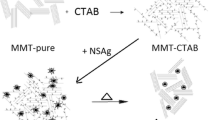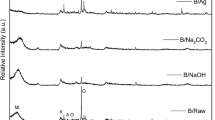Abstract
The aim of this work is to synthesize and characterize a new structured silver–clay dried, calcined or sintered at different temperatures composite by TG–DTA analysis, FTIR spectrometry analysis, XRD and Rietveld refinement, WD-XRF spectrometry, FEG–SEM images and EDS chemical analysis and to evaluate the antibacterial capacity of the new composite by the diffusion disk test against E. coli strains to attend water potability parameters. TG–DTA curves of Bco_dried suggested the presence of kaolinite, muscovite and hydrotalcite by the different events of structural water loss at different atmospheres. The interaction of Ag–clay might have occurred with hydrotalcite as can be inferred by the disappearance of the event at 408.9 °C (N2) and 433.4 °C (air). FTIR spectra showed that the modification occurred because of the changes that can be observed in the band range of (750 ≤ ν ≤ 1350) cm−1 for inner –OH and Si–O bonds. The Bco_dried composition was quantified by XRD and Rietveld refinement, and crystalline phases are quartz, calcite, kaolinite, hydrotalcite, muscovite, and portlandite. After sintering, the material presented the formation of new crystalline phases, due to the loss of structural water. When modified, the sample had no characteristic peaks of hydrotalcite, suggesting an interaction with Ag species. The compositions estimated for all samples by WD-XRF are mostly of Si, Al, Ca, K, Mg, Fe, Ti, and Ag. After modification, Ag increased significantly for Pca4_dried and Pca4_sint. SEM images presented the hexagonal characteristic of layered clay material and showed the interaction with Ag added. The susceptibility test showed that Pca4_dried has an antibacterial capacity against E. coli JM107 strains.









Similar content being viewed by others
References
Prüss-Ustün A, Bartram J, Clasen T, Colford JM, Cumming O, Curtis V, et al. Burden of disease from inadequate water, sanitation and hygiene in low- and middle-income settings: a retrospective analysis of data from 145 countries. Trop Med Int Health. 2014;19:894–905.
Bergaya F, Lagaly G. Surface modification of clay minerals. Appl Clay Sci. 2001;19:1–3.
Jiang JQ, Ashekuzzaman SM. Development of novel inorganic adsorbent for water treatment. Curr Opin Chem Eng [Internet]. 2012;1:191–9. https://doi.org/10.1016/j.coche.2012.03.008.
Bailey SE, Olin TJ, Mark Bricka R, Dean Adrian D. A review of potentially low-cost sorbents for heavy metals. Water Res. 1999;33:2469–79.
Lagaly G. Introduction: from clay mineral-polymer interactions to clay mineral-polymer nanocomposites. Appl Clay Sci. 1996;11:87–8.
Murray HH. Overview—clay mineral applications. Appl Clay Sci. 1991;5:379–95.
Horváth E, Kristóf J, Frost RL. Vibrational spectroscopy of intercalated kaolinites. Part I. Appl Spectrosc Rev. 2010;45:130–47.
Zsirka B, Horváth E, Járvás Z, Dallos A, Makó É, Kristóf J. Structural and energetical characterization of exfoliated kaolinite surfaces. Appl Clay Sci [Internet]. 2016;124–125:54–61. https://doi.org/10.1016/j.clay.2016.01.035.
Bergaya F, Lagaly G. Chapter 1 general introduction: clays, clay minerals, and clay science. Dev Clay Sci. 2006;1:1–18.
Grim RE. Applied clay mineralogy. New York: McGraw-Hill; 1962.
Albers APF, Melchiades FG, Machado R, Baldo JB, Boschi AO. Um método simples de caracterização de argilominerais por difração de raios X. Cerâmica. 2002;48:34–7.
Menezes RR, Souto PM, Santana LNL, Neves GA, Kiminami RHGA, Ferreira HC. Argilas bentoníticas de Cubati, Paraíba, Brasil: Caracterização física-mineralógica. Cerâmica. 2009;55:163–9.
Tombacz E, Szekeres M. Colloidal behavior of aqueous montmorillonite suspensions: the specific role of pH in the presence of indifferent electrolytes. Appl Clay Sci. 2004;27:75–94.
Fernandes MVS, Silva LRDda. Síntese e caracterização de vermiculita mesoporosa obtida por modificação com sais complexos de alumínio e lantânio. Cerâmica [Internet]. 2014;60:205–10.
Franzin BT, Lupi CP, Martins LA, Guizellini FC, dos Santos CCM, Pastre IA, et al. Thermal and electrochemical studies of Fe(III) organophilic montmorillonite. J Therm Anal Calorim. 2018;131:713–23.
Lupi CP, Franzin BT, Pereira PR, Damaceno AJ, Dadamos TRD, dos Santos CCM, et al. Thermal and electrochemical studies of Cu(II) 8-hydroxyquinoline organophilic montmorillonite. J Therm Anal Calorim. 2018;131:799–810.
Pastre IA, Oliveria ID, Moitinho ABS, de Souza GR, Ionashiro EY, Fertonani FL. Thermal behaviour of intercalated 8-hydroxyquinoline (oxine) in montmorillonite clay. J Therm Anal Calorim. 2004;75:661–9.
Farhanian S, Hatami M. Thermal and morphological aspects of silver decorated halloysite reinforced polypropylene nanocomposites. J Therm Anal Calorim. 2017;130:2069–78.
Hashemian S, Reza Shahedi M. Novel Ag/kaolin nanocomposite as adsorbent for removal of acid cyanine 5R from aqueous solution. J Chem. 2013;2013:1–7.
Sadasivam S, Rao SM. Characterization of silver–kaolinite (AgK): an adsorbent for long-lived 129I species. SpringerPlus. 2016;5:142. https://doi.org/10.1186/s40064-016-1855-8.
Valaskova M, Hundakova M, Mamulova Kutlakova K, Seidlerova J, Capkova P, Pazdziora E, et al. Preparation and characterization of antibacterial silver/vermiculites and silver/montmorillonites. Geochim Cosmochim Acta. 2010;74:6287–300.
Karel FB, Koparal AS, Kaynak E. Development of silver ion doped antibacterial clays and investigation of their antibacterial activity. Adv Mater Sci Eng. 2015. https://doi.org/10.1155/2015/409078.
Magana SM, Quintana P, Aguilar DH, Toledo JA, Angeles-Chavez C, Cortes MA, et al. Antibacterial activity of montmorillonites modified with silver. J Mol Catal A Chem. 2008;281:192–9.
Kim JS, Kuk E, Yu KN, Kim JH, Park SJ, Lee HJ, et al. Antimicrobial effects of silver nanoparticles. Nanomed Nanotechnol Biol Med. 2007;3:95–101.
Rai M, Yadav A, Gade A. Silver nanoparticles as a new generation of antimicrobials. Biotechnol Adv. 2009;27:76–83.
Li WR, Xie XB, Shi QS, Zeng HY, Ou-Yang YS, Chen YB. Antibacterial activity and mechanism of silver nanoparticles on Escherichia coli. Appl Microbiol Biotechnol. 2010;85:1115–22.
Ajayan PM. Bulk Metal and Ceramics Nanocomposites. In: Ajayan PM, Schadler LS, Braun PV, editors. Nanocomposites Science and Technology. Weinheim: Wiley-VCH Verlag GmbH & Co. KGaA; 2003. pp. 1–75.
Liu J, Lee JB, Kim DH, Kim Y. Preparation of high concentration of silver colloidal nanoparticles in layered laponite sol. Coll Surf A Physicochem Eng Asp. 2007;302:276–9.
Zhang X, Yang CW, Yu HQ, Sheng GP. Light-induced reduction of silver ions to silver nanoparticles in aquatic environments by microbial extracellular polymeric substances (EPS). Water Res. 2016;106:242–8.
Babos DV, Costa VC, Speranca MA, Pereira ER. Direct determination of calcium and phosphorus in mineral supplements for cattle by wavelength dispersive X-ray fluorescence (WD-XRF). Microchem J. 2018;137:272–6.
Clinical and Laboratory Standards Institute (CLSI). Performance Standards for Antimicrobial Disk Susceptibility Tests. 12th edn. Pennsylvania: CLSI; 2015.
American Society for Testing and Materials (ASTM). ASTM C114-18: Standard Test Methods for Chemical Analysis of Hydraulic Cement. Pennsylvania: ASTM International. 2018. https://doi.org/10.1520/C0114-18.
Vagvolgyi V, Palmer SJ, Kristof J, Frost RL, Horvath E. Mechanism for hydrotalcite decomposition: a controlled rate thermal analysis study. J Coll Interface Sci. 2008;318:302–8.
Gaines GL, Vedder W. Dehydroxylation of muscovite. Nature [Internet]. 1964;201:495. https://doi.org/10.1038/201495a0.
Bayliss P, Warne SSJ. Differential thermal analysis of siderite–kaolinite mixtures. Am Mineral. 1972;57:960–6.
Rowland RA. Differential thermal analysis of clays and carbonates. Clays Clay Miner [Internet]. 1952;1:151–63. https://doi.org/10.1346/CCMN.1952.0010118.
Zhang J, Xu YF, Qian GG, Xu ZP, Chen C, Liu Q. Reinvestigation of dehydration and dehydroxylation of hydrotalcite-like compounds through combined TG–DTA–MS analyses. J Phys Chem C. 2010;114:10768–74.
Chiu Y, Rambabu U, Hsu MH, Shieh HPD, Chen CY, Lin HH. Fabrication and nonlinear optical properties of nanoparticle silver oxide films. J Appl Phys. 2003;94:1996–2001.
Paulik F, Paulik J, Arnold M. Examination of the decomposition of agno3 by means of simultaneous ega and tg method under conventional and quasi isothermal circumstances. Thermochim Acta. 1985;92:787–90.
Waterhouse GIN, Bowmaker GA, Metson JB. The thermal decomposition of silver (I, III) oxide: a combined XRD, FT-IR and Raman spectroscopic study. Phys Chem Chem Phys. 2001;3:3838–45.
Otto K, Acik IO, Krunks M, Tonsuaadu K, Mere A. Thermal decomposition study of HAuCl4 center dot 3H(2)O and AgNO3 as precursors for plasmonic metal nanoparticles. J Therm Anal Calorim. 2014;118:1065–72.
Negishi A, Ozawa T. The effect of grinding on DTA curves of silver nitrate. Thermochim Acta [Internet]. 1971;2:89–91.
Charlot G. Les réactions chimiques en solution: l’analyse qualitative minérale. 6th ed. Paris: Masson et Cie; 1969.
Obadiah A, Kannan R, Ravichandran P, Ramasubbu A, Kumar SV. Nano hydrotalcite as a novel catalyst for biodiesel conversion. Dig J Nanomater Biostruct. 2012;7:321–7.
Nakamoto K. Infrared and Raman spectra of inorganic and coordination compounds. Hoboken: Wiley; 1977.
Farmer VC, Russell JD. The infra-red spectra of layer silicates. Spectrochim Acta. 1964;20:1149–73.
Karakassides MA, Gournis D, Petridis D. An infrared reflectance study of Si–O vibrations in thermally treated alkali-saturated montmorillonites. Clay Miner. 1999;34:429–38.
Ritz M, Vaculikova L, Plevova E, Matysek D, Malis J. Determination of chlorite, muscovite, albite and quartz in claystones and clay shales by infrared spectroscopy and partial least-squares regression. Acta Geodyn Geomater. 2012;9:511–20.
Horgnies M, Chen JJ, Bouillon C. Overview about the use of Fourier transform infrared spectroscopy to study cementitious materials. WIT Trans Eng Sci. 2013;77:251–62.
Vieira CMF, Sales HF, Monteiro SN. Efeito da adição de argila fundente ilítica em cerâmica vermelha de argilas cauliníticas. Cerâmica. 2004;50:239–46.
Abello S, Medina F, Tichit D, Perez-Ramirez J, Groen JC, Sueiras JE, et al. Aldol condensations over reconstructed Mg–Al hydrotalcites: structure-activity relationships related to the rehydration method. Chem Eur J. 2005;11:728–39.
Debecker DP, Gaigneaux EM, Busca G. Exploring, tuning, and exploiting the basicity of hydrotalcites for applications in heterogeneous catalysis. Chem Eur J. 2009;15:3920–35.
Baes CF, Mesmer RE. The hydrolysis of cations. New York: Wiley; 1976.
Miyata S. Anion-exchange properties of hydrotalcite-like compounds. Clays Clay Min. 1983;31:305–11.
Huang HT, Yang Y. Preparation of silver nanoparticles in inorganic clay suspensions. Compos Sci Technol. 2008;68:2948–53.
Chakraborty AK. Formation of silicon–aluminum spinel. J Am Ceram Soc [Internet]. 1979;62:120–4.
Chernousova S, Epple M. Silver as antibacterial agent: ion, nanoparticle, and metal. Angew Chem Int Ed. 2013;52:1636–53.
Thurman RB, Gerba CP, Bitton G. The molecular mechanisms of copper and silver ion disinfection of bacteria and viruses. Crit Rev Environ Control [Internet]. 1989;18:295–315.
Patakfalvi R, Oszko A, Dekany I. Synthesis and characterization of silver nanoparticle/kaolinite composites. Coll Surf A Physicochem Eng Asp. 2003;220:45–54.
Benli B, Yalm C. The influence of silver and copper ions on the antibacterial activity and local electrical properties of single sepiolite fiber: a conductive atomic force microscopy (C-AFM) study. Appl Clay Sci. 2017;146:449–56.
Acknowledgements
This work was supported by Cerâmica Stéfani and SPR Consultoria Metrológica. We would like to thank the LabCACC (São Paulo State University, Araraquara) for XRD facilities, GAIA (São Carlos Federal University, São Carlos) for WD-XRF facilities, Laboratório de Sucroquímica e Química Ambiental (LSQA) (São Paulo State University, São José do Rio Preto-SP) for ATR-FTIR facilities and the LMA-IQ for FEG–SEM facilities.
Author information
Authors and Affiliations
Corresponding author
Additional information
Publisher's Note
Springer Nature remains neutral with regard to jurisdictional claims in published maps and institutional affiliations.
Electronic supplementary material
Below is the link to the electronic supplementary material.
Rights and permissions
About this article
Cite this article
Guizellini, F.C., Franzin, B.T., da Silva, M.A. et al. Thermal, morphostructural and spectrometric characterization of an antibacterial kaolinite-based filter modified with silver for water treatment. J Therm Anal Calorim 143, 47–60 (2021). https://doi.org/10.1007/s10973-020-09267-w
Received:
Accepted:
Published:
Issue Date:
DOI: https://doi.org/10.1007/s10973-020-09267-w




